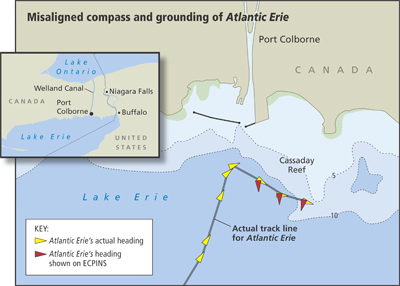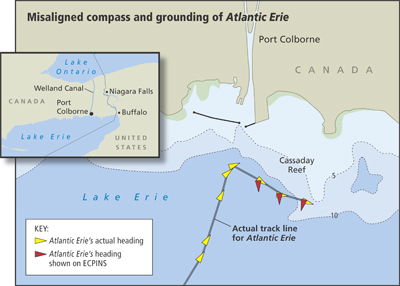 |
|
Investigators said Atlantic Erie ran aground after the crew followed electronic navigation headings that were inaccurate because an earlier power interruption had resulted in a misaligned gyrocompass. |
|
Pat Rossi illustration/Source: TSB |
A power loss, followed by wayward navigation based upon a misaligned gyrocompass, caused a bulk carrier to run aground in 2014 near Port Colborne, Ontario, the Transportation Safety Board of Canada (TSB) said.
When a circuit breaker to the bow thruster tripped on Atlantic Erie on June 12, 2014, it initiated a concatenation of events including power interruptions to the bridge that led to the grounding of the vessel. Investigators identified a succession of human errors in how the officers responded.
The 736-foot dry bulk cargo ship, owned by CSL Group Inc., was eastbound in Lake Erie en route from Chicago to Sydney, Nova Scotia. The TSB report said Atlantic Erie was approaching the upper entrance to Welland Canal.
The engineer of the watch (EOW) started the No. 3 generator and synchronized it with the No. 1 generator, which had been providing electrical power to the vessel. The master reported in to Seaway Welland vessel traffic control at 0942 while reducing speed and altering course to port.
When the vessel was 1.5 nm south of the outer piers at Port Colborne, proceeding at a speed of about 9 knots, the master called the EOW and requested the bow thruster. After the bow thruster had been running for one minute, the EOW transferred the controls to the bridge. The bow thruster ran for approximately one more minute without being used, at which point its circuit breaker tripped, according to the TSB report.
A cascading series of events led to the grounding.
When the EOW reset the circuit breaker and attempted to restart the bow thruster, the voltage in the electric distribution system dropped and the No. 3 generator main circuit breaker tripped, but the No. 1 generator continued powering the main switchboard. The main engine continued to operate, and the lights remained on throughout the vessel.
“In this occurrence, a voltage drop on the bridge escalated into an emergency after subsequent actions in the engine control room (ECR) caused multiple brief power interruptions to the bridge navigational equipment, and the gyrocompass became misaligned,” the investigators wrote.
The gyrocompass was not verified following the power interruption. The helmsman was steering the ordered course of 180°G using a gyrocompass repeater that was becoming increasingly misaligned, guiding the vessel off course.
“The master, who was not using all available bridge resources to monitor the vessel’s position and course, did not identify the vessel’s deviation until it was too late for corrective action and the Atlantic Erie ran aground,” the TSB report stated.
The TSB noted that the bow thruster circuit breaker tripped and caused a voltage drop throughout the vessel. That activated power failure alarms on the bridge. The alarms created a situation that resembled a blackout and was interpreted as such.
When a crewmember informed the master that there was smoke coming from the bow thruster compartment, he activated the general alarm. He attempted to make an announcement stating that this was not a drill and asked crew to proceed to muster stations. The message did not transmit throughout the vessel, however, because the master had mistakenly picked up the handset for the VHF radiotelephone instead of the handset for the public address (PA) system.
“The chief engineer responded to the developing situation by applying the vessel’s blackout procedure twice, which caused additional power interruptions to the bridge; however, the chief engineer was unaware that his actions were having this effect,” the report stated.
These power interruptions, combined with the vessel’s turn to starboard, caused the gyrocompass to become misaligned. The gyro was not verified for accuracy, and the master was now navigating using inaccurate data from the electronic chart precise integrated navigation system (ECPINS).
“The master was not using all available bridge resources to monitor the vessel’s progress, and the vessel proceeded off its intended course for approximately 15 minutes,” the report added.
When the master identified that Atlantic Erie was not following the intended course, he attempted to take corrective action. It was too late to be effective, and at 1020 the vessel ran aground 1.5 nm southeast of the Port Colborne outer piers.
A post-occurrence diving inspection determined that both the shell plating and the forward transverse bulkhead, located between the forepeak tank and the bulbous bow void space, were cracked.
The TSB wrote that if a bridge team does not make use of all available resources, both human and technical, to monitor the vessel’s progress, errors may go undetected.
If an alarm does not continue to activate until acknowledged by an operator, there is a risk that the underlying problem may be overlooked and secondary effects on equipment may go unnoticed.
The reason for the bow thruster’s failure could not be conclusively determined. The TSB laboratory found that the most likely cause for the electrical issues at the time of the occurrence was a short between the windings in the bow thruster motor.
TSB found that the checklist to follow in the event of a gyrocompass failure had been removed from the vessel’s safety management system with the intent to add it to the shipboard contingency plan. This had not yet been done.
The investigators said Atlantic Erie’s PA and VHF handsets on the bridge central console are similar in appearance, are located close together, and had been mistaken for one another in the past.
Following the incident, the master wrote a letter that was circulated to the fleet masters providing an explanation of what had happened and why. The master’s letter was used to develop a case study exercise that has been incorporated into Human Element Leadership Management (HELM) training.
In an email to Professional Mariner, CSL Group spokeswoman Brigitte Hebert said the company is satisfied with the results of the report and agrees with its finding.

